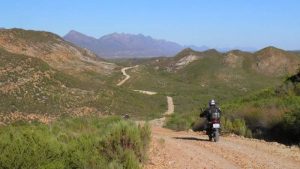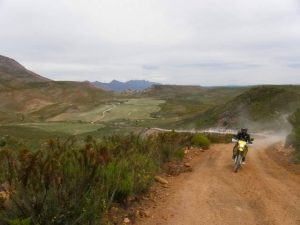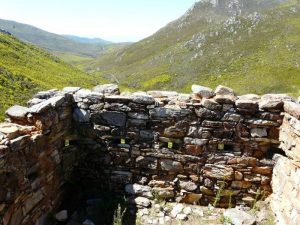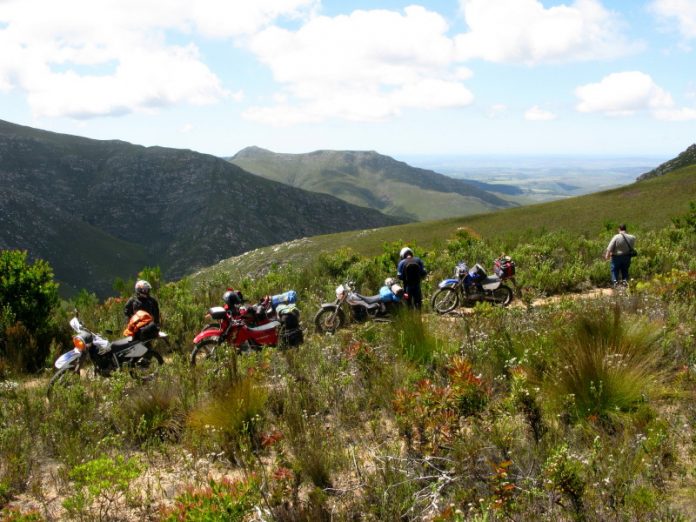Attaquaskloof – Valley of Violence
Article and photos: Johann van Tonder
In our previous issue we started the Ox-Wagon N1 story in Heidelberg and crossed the mountain into the Klein Karoo via the Gysmanshoek Pass. In this issue we continue our historic journey. We travel East on the gravel R327 which takes us over Gouritz River and on to Cloetes Pass (and eventually Herbertsdale). But before we reach Cloetes Pass we to turn East towards Attaquaskloof.
The turnoff into the kloof is indicated by a little Ox Wagon sign, but it’s easy to miss. The coordinates of the turnoff is S33 54.373 E21 42.696. Moving into the kloof you move up and over hills constantly, which makes for excellent views. No fences, no other traffic. Just a trail in Africa. This is the type of thing I love.

This valley was first inhabited by the bushmen or Khoi San, who were present until the 1700’s as there are paintings of persons riding horses with rifles and hats on their heads. A fierce Khoi-Khoi tribe called the Attaqua also inhabited the valley (arriving after the San), hence the name Attaquaskloof.
The Attaqua were a particularly aggressive tribe who not only drove the San out of the valley, but also clashed regularly with the other Khoi-Khoi tribes, such as the Gourikwa, Hessekwa and Inca.
In 1668 an official of the VOC (Dutch East India Company), Hieronymus Cruze, led a trading company in the area. They investigated the possibility of a harbour in Mossel Bay. Cruze had contact with the Attaqua Koi “who lived in a mountain valley” (Attaquas Kloof), but it was not till 1689 (37 years after the arrival of Jan van Riebeeck) that the first white man stuck his nose over the Attakwas Pass into the Klein Karoo.

The first European to set foot in this valley was Ensign Isaac Schrijwer in February 1689. He led an expedition of 21 men and two ox wagons, sent by Simon van der Stel, to barter for cattle and sheep with the Inca Khoi-Khoi near Aberdeen. Isaac Schrijwer traveled along the coast to Mossel bay. He remembered Cruze’s report about the Attaqua Koi, but found that they had moved North into the Channa Land search of better grazing. He followed them out of the Kloof over the mountains following an elephant track. The area was densely overgrown and the elephant track had to be widened to take the wagons. This involved quite a bit of manual labour and the crossing took them seven days, four of which on this small section. On their return with numerous cattle and sheep, they were attacked by the Attaqua Khoi-Khoi, who took all the cattle and sheep. The following morning Schrijwer followed the spoor and cornered the Khoi-Khoi in Grootkloof. A fierce battle followed. That was not the last blood that flowed in this kloof.
Isaac Schrijwer’s route over Attaquas mountain pass opened up the inland and soon this valley was ‘n busy trade route that flourished for 180 years. A town called Woeska was established and did brisk trade in this valley. Some of the old buildings can still be seen, though sadly it is not being looked after and in a worse state every time we pass. Amazing to think that people lived and made a living there for more than a century and today there is nothing left.
Once through the kloof you find yourself on Bonniedale Adventure Farm which boasts several 4×4 routes and is ‘n popular breakaway destination. The first European to settle on Bonniedale Farm was a Scotsman in 1860. He had a toll concession to maintain the pass from Bonniedale to the summit of the Attaquas mountains. He also supplied mules, oxen and other produce to passing travellers.
It is from here that we tackle the pass, the same elephant route Schrijwer took all those years ago. This route runs through the Attakwas Nature Reserve and access is restricted.

The route passes an old toll house, as well as the Attaquas hut. It’s also the spot of a commemorative plaque for Attaquas Kloof Pass. The hut is used by hikers walking along the Attaquas Hiking Trail. Sleep here at your own peril, for this is close to the spot where the notorious Bloubaard Swanepoel is burried. He has an unmarked grave near a tree that was fenced off. Bloubaard’s claim to fame was the fact that he was the last person to be publicly hanged in South Africa (on the town square in George).
He was convicted on numerous counts of murder of persons who had bought cattle from him. After the sale he would ride over the Attaquas Mountains and ambush them on their way out with cattle, kill them and take the cattle back. He did this on four occasions but on the fifth occasion he did not see one of his potential victims who had gone to the bush to relieve himself. A lot of blood flowed in Attaquas kloof. It’s hard to marry that ugly truth to the natural splendour found here.


As was the case with Gysmanshoek Pass, the Boer’s during the Anglo-Boer War knew about all these little abandoned passes in the area, so they had to be guarded. Near the summit of Attaquas Pass you find the remains of an old English Fort. And on the Oudtshoorn side of the mountain you find the remains of yet another settlement. This spot had an hotel and general dealer and would have been a perfect stop for travellers before crossing the mountain en route to Mossel bay.
Sadly not much is known today about this settlement. It is situated on the farm Saffraanrivier and the old hotel was apparently called “Die Bonthuis”. Rumour has it that there was a murder here and one of the owners hung himself from a tree in front of the hotel, but there are no documented proof of this (that I know of). Sue van Waarts mentions this in one of her books.
Attaquas Pass crosses the mountains a mere six kilometres West of present-day Robinson Pass and this route exits on Robinson pass at S33 49.079 E22 02.314 The whole route (as well as the other 4×4 trails) are mapped on the Tracks 4 Africa maps.
For more information on this route contact Nico and Danette Hesterman of Bonniedale
Holiday Farm on 044-695 3175; e-mail: bonniedale@mweb.co.za or look at their website: www.bonniedale.com
Oorspronklike artikel was in Ultimate Lifestyle Ed.6







